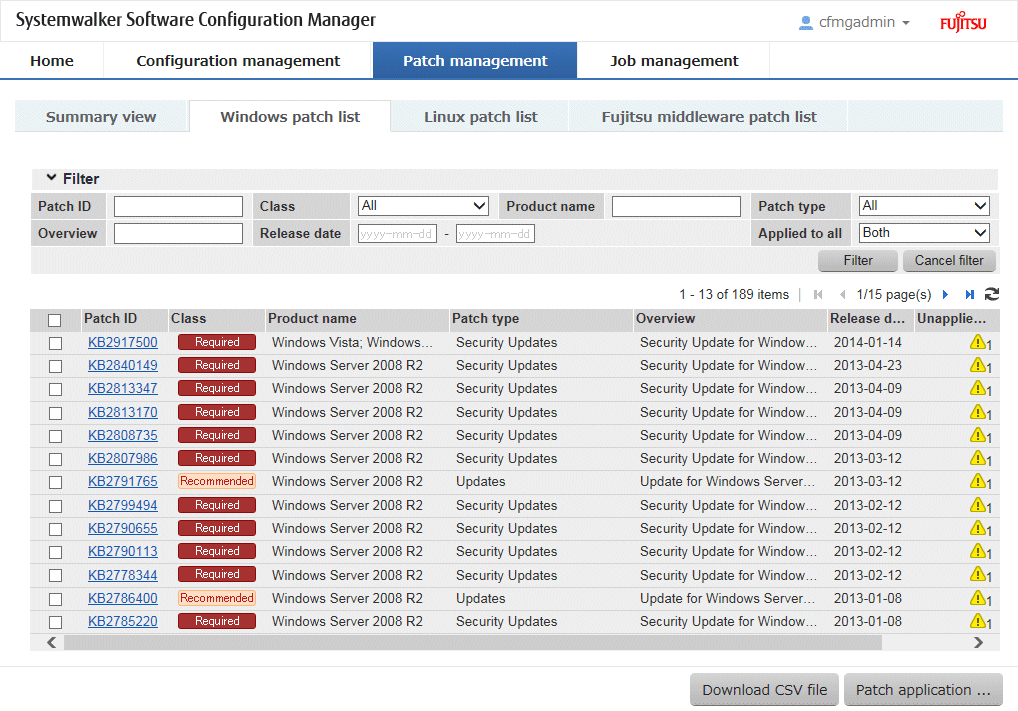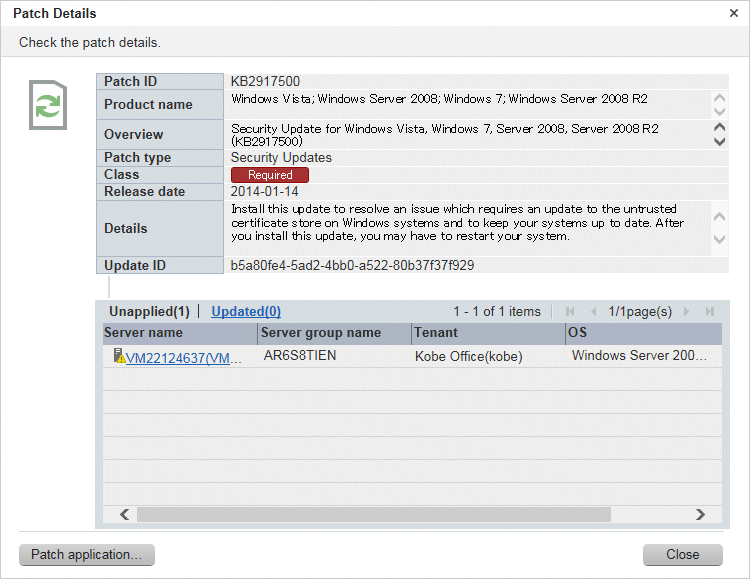Display method
Use either of the following methods to display the patch list:
Select Patch management from the menu in the management console.
Click the Patch management link in the Home window.
Patch lists for Windows operating systems, Linux operating systems and Fujitsu middleware can be displayed by selecting each tab.
All of the patches obtained from WSUS are displayed in the list of Windows patches, except for those patches that the infrastructure administrator has not approved on WSUS.
For Linux patches, the patches that have been registered with the yum repository server and have been defined as the management target are displayed. For Fujitsu middleware patches, the patches that have been registered with Systemwalker Software Configuration Manager are displayed.
The number of servers to which each patch has not been applied can also be displayed.
Users with all roles can reference information about all patches. However, if a tenant administrator or tenant user logs in, the results displayed for the number of servers with unapplied patches will be filtered by the tenants or the range of servers that the tenant administrator or tenant user manages.

Operation method
Specify the conditions for filtering the information in the patch list. The filter conditions shown below can be specified for each patch type. Multiple filter conditions can be specified.
Patch type | Filter conditions |
|---|---|
Windows patch list |
|
Linux patch list |
|
Fujitsu middleware patch list |
|
The following table shows the items that are displayed in the patch list:
Display item | Description |
|---|---|
Checkboxes | Specifies the patch to be applied. |
Patch ID | Displays the patch IDs. Clicking a patch ID link displays the Patch Details window. |
Class | Displays the classification levels of the patches.
|
Product name | Displays the product name (operating system name) corresponding to each patch. |
Patch type | Displays the patch types. (This indicates the classification of updates, which represents the WSUS update program type.)
|
Overview | Displays a title for each patch. |
Release date | The date when the vendor (Microsoft) released the patch |
Unapplied servers | Displays the number of machines where the patch has not been applied. The number of servers without patches that the infrastructure administrator has not approved on WSUS is not counted. Also, the total number of machines displayed here is only for the machines within the range that can be looked up by the login user. |
Item | Description |
|---|---|
Checkboxes | Specifies the patch to be applied. |
Package name | Displays the names of the RPM packages. Clicking a package name link displays the Patch Details window. |
Version | Displays the versions of the packages. |
Release | Displays the release numbers of the packages. |
Architecture | Displays the architecture for each package. |
Overview | Displays an overview of each package. Displays in English. |
Release date | Displays the date when the package information was registered with Systemwalker Software Configuration Manager. |
Unapplied servers | Displays the number of machines where the patch has not been applied. The number of servers with unapplied patches is not counted if these patches have been registered with the yum repository server but have not been defined as the Linux patch management target. Also, the total number of machines displayed here is only for the machines within the range that can be looked up by the login user. |
Item | Description |
|---|---|
Checkboxes | Specifies the patch to be applied. |
Patch ID | Displays the patch IDs. |
Class | Displays the classification levels of the patches.
|
Importance | Displays the importance of each patch.
|
Update type | Displays the update types of the patches.
|
Product name | Displays the product names. |
OS | Displays the operating systems (platforms). |
Update title | Displays the update titles of the patches. |
Release date | Displays the release dates of the patches. |
Unapplied servers | Displays the number of machines where the Fujitsu middleware patches registered using swcfmg_fjmwpatch_update (Fujitsu middleware patch registration command) have not been applied. Also, the total number of machines displayed here is only for the machines within the range that can be looked up by the login user. |
The following operations can be performed from the patch list window.
Operation button | Description |
|---|---|
Download CSV file | Output patch list information in CSV format. If the information displayed has been filtered, only the filtered information will be output. |
Patch application | Displays the Patch Application wizard, enabling the user to configure patch distribution and patch application for a specified patch. |
Note
Patches with prerequisite patches
For Windows patches, if a patch has a prerequisite patch and neither the patch nor the prerequisite patch have been applied to a business server, the business server may not be counted as a server with unapplied patches, even though it has the same environment (the same operating system) as other business servers.
This is because when the patch is released by WSUS it is managed as an "applicable" patch but when a "check for update programs" operation is performed on the business server the patch will be managed as "not applicable" if the prerequisite patch has not been applied.
Systemwalker Software Configuration Manager does not handle "not applicable" patches as unapplied patches when counting the number of servers with unapplied patches.
Display method
Use either of the following methods to display the patch details:
Click a patch ID link in the patch list window.
Click a patch ID link in each window.
The Patch Details window will be displayed.
The Patch Details window shows a description of the patch, and the patch application status.

Operation method
Detailed information about the patch is displayed in the top section of the window.
The following table shows the items that are displayed in the patch list:
Item | Description |
|---|---|
Patch ID | Displays the patch ID. |
Product name | Displays the product name (operating system name) corresponding to the patch. |
Overview | Displays the patch overview (or for Windows, the title). |
Patch type | Displays the patch type. (This indicates the classification of updates, which represents the WSUS update program type.)
|
Class | Displays the classification level of the patch.
|
Release date | Displays the date when the vendor (Microsoft) released the patch. |
Details | Displays a detailed description of the patch that is provided by the vendor. |
Update ID | Displays the Update ID. |
Item | Description |
|---|---|
Package name | Displays the name of the package. |
Version | Displays the version of the package. |
Release | Displays the release number of the package. |
Architecture | Displays the architecture for each package. |
Release date | Displays the date when the package information was registered with Systemwalker Software Configuration Manager. |
Overview | Displays an overview of the package. Displays in English. |
Details | Displays a detailed description of the patch that is provided by the vendor. Displays in English. |
Item | Description |
|---|---|
Patch ID | Displays the patch ID. |
Class | Displays the classification level of the patch.
|
Importance | Displays the importance of the patch.
|
Update type | Displays the update types of the patch.
|
Product name | Displays the product name. |
OS | Displays the operating system (platform). |
Release date | Displays the release date of the patch. |
Update title | Displays the update title of the patch. |
The bottom section of the window displays a list of the servers where the patch has not been applied and a list of the servers where the patch has been applied.
Clicking an Unapplied link displays a list of servers with unapplied patches.
Clicking an Updated link displays a list of servers with applied patches.
Item | Description |
|---|---|
Server name | Displays the server names. |
Server group name | Displays the server group name. |
Tenant | Displays the tenant. |
OS | Displays the operating system names. |
The following operations can be performed from the List of Servers with Unapplied Patches window.
Operation button | Description |
|---|---|
Patch application | Displays the Patch Application wizard, enabling the user to configure patch distribution and patch application for a specified patch. |
Close | Closes the window. |